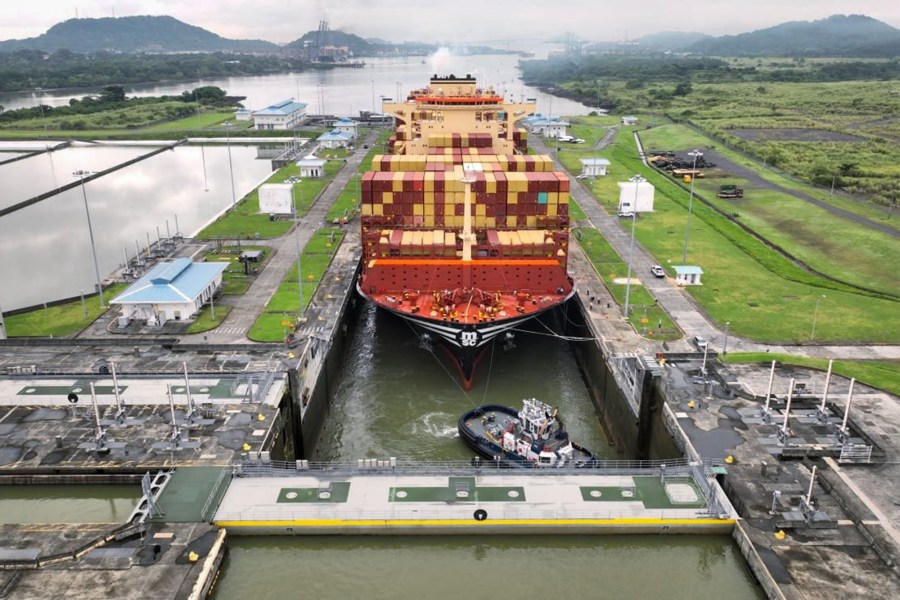President-elect Donald Trump blurted out another outrageous promise at a Turning Point USA event Sunday in Phoenix: He now wants the Panama Canal back. Trump claimed that Panama’s shipping fees were “ridiculous” and threatened to demand the canal’s return if these fees aren’t reduced.
“I can proudly proclaim that the Golden Age of America is upon us,” Trump said. “There’s a spirit that we have now that we didn’t have just a short while ago.”
Why Trump now wants the U.S. to repossess the canal remains unclear.
Trump’s invocation of a “Golden Age” will always excite his supporters, who thrill at his call to “Make America Great Again.” But for much of Latin America, the era that slogan harks back to was defined by U.S. imperialism and exploitation. Panama knows this history better than most, having endured decades of American control over a canal that defines not just the country’s economy but its very identity.
Trump’s notion to take back the canal is not just inflammatory. It risks reigniting tensions between the U.S. and many Latin American countries, after those countries have worked hard to move past fears about American intrusions on their sovereignty. Panamanian President José Raúl Mulino swiftly rebuked Trump, stating, “Every square meter of the Panama Canal and its adjoining zone is Panama’s and will remain so. The sovereignty and independence of our country is non-negotiable.”
It’s worth noting that during his first term, Trump was praising the canal in a meeting with Mulino’s predecessor, Juan Carlos Varela (no relation). “The Panama Canal is doing quite well,” he said to Varela and reporters in 2017. “I think we did a good job building it.” Varela reminded Trump that the U.S. work on the canal happened “one hundred years ago.”
Indeed, in 1903 Panama’s ambassador in Washington signed a treaty with the U.S. granting the latter the rights to build and run the canal. It was built over the following decade; thousands of workers died, most of them Afro Panamanian and Caribbean. In 1977, the two countries signed the Torrijos-Carter Treaties, which set a path for Panama to regain control of the canal at the end of 1999.

Why Trump now wants the U.S. to repossess the canal remains unclear. But his comments are part of a long history of U.S. interference in Latin America, where the 201-year-old Monroe Doctrine still looms large. Back in 1823, President James Monroe issued the doctrine as a way of speaking out against meddling by European powers. But those ideas “soon became a watchword of U.S. policy in the Western Hemisphere,” according to the National Archives, essentially guiding American intervention and imperialism in Latin America for two centuries.
Dated rhetoric about taking back the Panama Canal reveals the broader pattern of U.S. interference that treats Latin America as a resource to be controlled. Trying to reclaim this bygone symbol of American dominance because Trump says so is as imperialistic as it gets.
There was a time when the United States recognized that its control over the Panama Canal had caused too much violence and damage. The Torrijos-Carter Treaties came after decades of tension, unrest, and growing resistance from the Panamanian people, who had long been at odds with U.S. dominance over such a vital national resource. It not only formally acknowledged Panama’s sovereignty but was also a necessary step to address international calls for a redefined relationship between the U.S. and Panama.
How quickly we forget the joy Panamanians felt when the canal was finally theirs.
But the story didn’t end with the treaties. In 1989, the United States invaded Panama to depose President Manuel Noriega, on the grounds of protecting American lives and interests. After the treaties’ promise of a peaceful transition for control of the canal, the invasion left a lasting mark on U.S.-Panama relations, resulting in significant loss of life and deepening Panama’s mistrust of American intervention.













